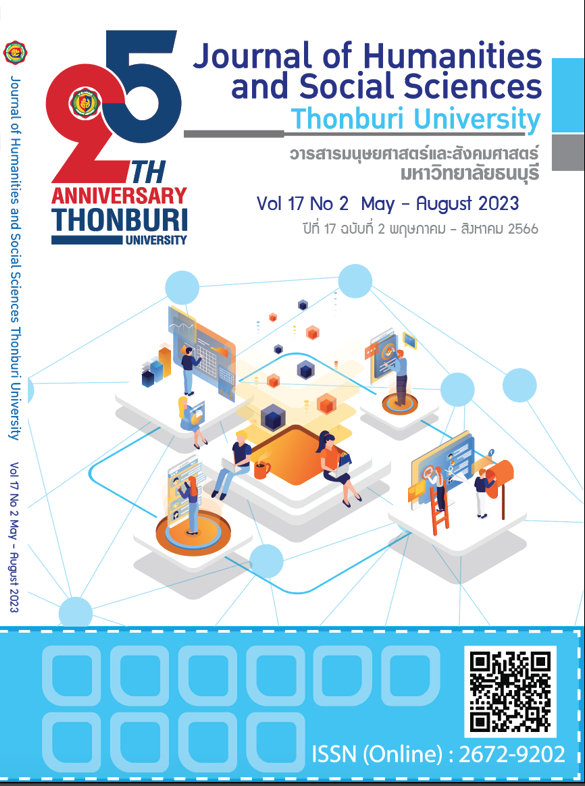สภาพแวดล้อมและวัฒนธรรมองค์กรต่อการธำรงรักษาบุคลากร
Main Article Content
บทคัดย่อ
บทความนี้มีวัตถุประสงค์ 1. เพื่อศึกษาแนวคิด ทฤษฎี และงานวิจัยที่เกี่ยวข้องกับสภาพแวดล้อมในประเด็นของ ความพึงพอใจในงาน ความผูกพัน และการรับรู้ถึงการสนับสนุนขององค์กร 2. เพื่อศึกษาแนวคิด ทฤษฎี และงานวิจัยที่เกี่ยวข้องกับวัฒนธรรมองค์กรในประเด็นของความรู้ทั่วไปของวัฒนธรรมองค์กร และองค์ประกอบของวัฒนธรรมองค์กร 3. เพื่อศึกษาความเชื่อมโยงระหว่างสภาพแวดล้อมและวัฒนธรรมองค์กรในองค์กร 4. เพื่อศึกษาแนวคิด ทฤษฎี และงานวิจัยที่เกี่ยวข้องกับการธำรงรักษาบุคลากรในประเด็นของคำจำกัดความของการธำรงรักษาบุคลากร และองค์ประกอบของการธำรงรักษาบุคลากร
5. เพื่อศึกษาสภาพแวดล้อมและวัฒนธรรมองค์กรต่อการธำรงรักษาบุคลากร 6. เพื่อเสนอแนะแนวทางในการธำรงรักษาบุคลากร ในประเด็นของปัญหา อุปสรรค การแก้ไขปัญหา และข้อได้เปรียบโอกาสการพัฒนาต่อการธำรงรักษาบุคลากร
Article Details

This work is licensed under a Creative Commons Attribution-NonCommercial-NoDerivatives 4.0 International License.
ผลงานที่ปรากฎในวารสารฉบับนี้เป็นลิขสิทธิ์เฉพาะส่วนบุคคลของผู้เขียนซึ่งต้องรับผิดชอบต่อผลทาง กฎหมายที่อาจเกิดขึ้นได้และไม่มีผลต่อกองบรรณาธิการReferences
Adeoye, A., O. & Hope, O. (2020). Organizational Culture, Employee Retention and Employee Loyalty: Empirical Evidence from Nigeria. Academic Journal of Economic Studies, 6(3): 139–145.
Allen, D. G. & Shanock, L., R. (2013) Perceived Organizational Support and Embeddedness as Key Mechanisms Connecting Socialization Tactics to Commitment and Turnover among New Employees. Journal of Organizational Behaviour, 34: 350-369.
Anitha, J. & Begum, F., N. (2016). Role of Organizational Culture and Employee Commitment in Employee Retention. International Journal of Asian School of Business Management, 9(1): 17-28.
Armstrong, M. & Taylor, S. (2014). Armstrong’s Handbook of Human Resource Management Practice. 13thed. Philadelphia: Kogan Page Limited.
Armstrong, M. (2020). A handbook of human resource management practice. 10thed. Philadelphia: Kogan Page Limited.
Beardwell, J. & Thompson, A. (2017). Human Resource Management A Contemporary Approach. 8thed. United Kingdom: Pearson Education Limited.
Chatterjee, A., Pereira, A. & Bates, R. (2018). Impact of individual perception of organizational culture on the learning transfer environment. International Journal of Training and Development, 22(1): 15-33.
Christeen, G. (2015). Retaining Professional Workers: What Makes Them Stay?. Employee Relations, 37(1): 102-121.
Colquitt, J., A., LePine, J. A. & Wesson, M. J. (2019). Organization Behavior Improving Performance and Commitment in the Workplace (6th ed.). New York. McGraw-Hill.
Cross, R., Rollag, K., Opie, T. & Pryor, G. (2017). Connect and Adapt: How Network Development and Transformation Improve Retention and Engagement In Employees’ First Five Years. Organization Dynamics, 47(2): 115-123.
Das, B., L. & Baruah, M. (2013). Employee Retention: A Review of Literature. Journal of Business and Management, 14(2): 8-16.
Gaile, A. (2013). External Factors Facilitating Development of The Learning Organization Culture. Journal of Business Management, 7: 130-140.
Ghapanchi, A., H. & Aurum, A. (2011). Antecedents to IT Personnel’s Intentions to Leave: A Systematic Literature Review. Journal of Systems and Software, 84: 238-249.
Goldstein, H., W., Pulakos, E., D., Passmore, J. & Semedo, C. (2017). The Wiley Blackwell Handbook of the Psychology of Recruitment, Selection and Employee Retention. UK. John Wiley & Sons Ltd.
Inabinett, J., M. & Ballaro, J., M. (2014). Developing an Organization by Predicting Employee Retention by Matching Corporate Culture with Employee’s Values: A Correlation Study. Organization Development Journal, 32(1): 55-74.
James, L. & Mathew, L. (2012). Employee Retention Strategies: IT Industry. SCMS Journal of Indian Management, 9(3): 79-87.
Jeong, Y. & Kim, M. (2021). Effects of perceived organizational support and perceived organizational politics on organizational performance: Mediating role of differential treatment. Asia Pacific Management Review, 27(3): 190-199.
Kossivi, B., Xu, M., & Kalgora, B. (2016). Study on Determining Factors of Employee Retention. Open Journal of Social Sciences, 5(4), 261-268.
Loutier, O., Felusiak, L., Hill, C. & Pemberton-Jones, E., J. (2015). The Importance of Developing Strategies for Employee Retention. Journal of Leadership, Accountability and Ethics, 12(2): 119-129.
McShane, S., L. & Von Glinow, M., A. (2018). Organizational behavior emerging knowledge global reality (8th ed.). New York. McGraw-Hill Education.
Parmenter, J., & Barnes, R. (2021). Factors supporting Indigenous employee retention in the Australian mining industry: A case study of the Pilbara region. The Extractives Industries and Society, 8: 423-433.
Pittino, D., Visintin, F., Lenger, T., & Sternad, D. (2016). Are High Performance Work Practices Really Necessary in Family SMEs? An Analysis of the Impact on Employee Retention. Journal of Family Business Strategy, 7: 75-89.
Rhoades, L. & Eisenberger, R. (2012). Perceived Organizational Support: A Review of the Literature. Journal of Applied Psychology, 87(4): 698-714.
Robbins, S., P. & Judge, T., A. (2016). Essentials of Organizational Behavior (15th ed.). New Jersey. Pearson Education Limited.
Scandura, T., A. (2019). Essentials of Organizational Behavior an Evidence-Based Approach. 2eded. Los Angeles: SAGE Publications.
Schein, E., H. (2017). Organization culture and leadership. 5thed. New Jersey: John Wiley & Sons.
Sinding, K. & Waldstrom, C. (2014). Organization Behavior. 5thed. London: McGraw-Hill Education.
Singh, D. (2019). A Literature Review on Employee Retention with Focus on Recent Trends. IJSRST, 6(1): 425-431.
Wang, X., Zheng, X. & Zhao, S. (2021). Repaying the Debt: An Examination of the Relationship between Perceived Organizational Support and Unethical Pro organizational Behavior by Low Performers. Journal of Business Ethics, 179(3): 697-709.

